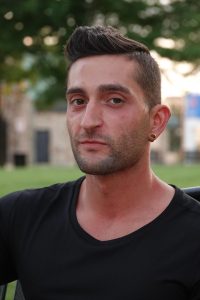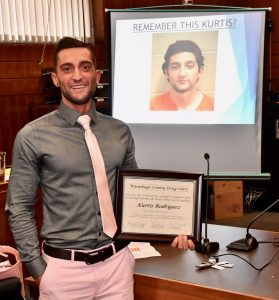‘Your mother just saved your life’
Kurtis Rodriguez’s path to recovery
September 30, 2020

Kurtis Rodriguez only had a few minutes to get ready in his mother’s basement. His father was waiting outside to take him to the Winnebago County Jail for his drug test. Being out on bond sucked. He had to report to the jail every other day to pee in a cup to ensure his sobriety. But there was no way Kurtis could stay sober. He needed his fix to function. So, of course, he found a loophole. In his pocket, he had a bottle of clean urine he had bought at a local tobacco store for $25 so he could pass his test. Before heading up the stairs, he took out a needle and injected the same amount of heroin he would any other day. That’s the last thing he remembered.
He woke up with two detectives, two paramedics and four cops standing over him. His parents were crying in the corner of the room. Kurtis was mad. “What the heck? What is going on? Why did you bring me back?” he yelled. You ruined my high. That’s money, and that’s my drug. “I was fine. You could have just left me.”

“You should be grateful,” one of the paramedics said. “Your mother just saved your life.”
2019: Living in Recovery
Today, Kurtis lives a different life. Far from the addict he used to be, Kurtis has improved his health: mentally, physically and spiritually. At 5 feet 5 inches and weighing 145 pounds, he has gained 50 pounds since emerging from the depths of his addiction. Nearing his darkest point, Kurtis lived on the streets weighing only 95 pounds. His hair, long and unkempt. Breakouts and acne dotted his face, and his facial hair was uneven and scraggly. Now, when he enters a room, he greets everyone with a warm smile and a “Hey! How’s it going?” His hair is styled into a neat flip, parted on the right side, and his facial hair is neatly trimmed. His lean muscles peeking out from his T-shirt sleeves could classify him as a welterweight boxer. “People see the difference,” Kurtis said. “Not many people have seen me at my worst, and there’s not many pictures of me either because I looked so bad, you wouldn’t want to take a picture of me. Now I’m the healthiest I’ve ever been.”
Jake Wissink, Kurtis’ friend since kindergarten who has also experienced addiction, agrees. Because he and Kurtis went through their darkest moments together, Jake has seen Kurtis through his addiction and recovery. “When we were using, we were dark, dark humans,” Jake said. “He only wanted to take from the world. Now, he tries putting positivity out in the world and gives advice to people who are still using.”
For Kurtis, working out has been an important remedy for his addiction. Despite long hours as a construction worker out in the summer heat, he still pumps iron five days a week. “The gym is another huge thing. It’s basically free medicine; it’s a free antidepressant. I don’t know why more people don’t do it. I learned to make time for what’s important.”
This change didn’t come easily, though. It would take Kurtis three and a half years, counseling, prison and the Winnebago County Drug Court to turn his life around.
1999: Where it all started
Kurtis had the typical childhood of many middle-class Americans. He had two loving parents that took him and his sister to their property up north for vacations. Kurtis loved those moments — surrounded by nature, totally at peace — because when they returned, he’d have to go back to normal life. He and his sister would have to return to school, and his parents would go back to work. His mother helped children and families as a therapist for Winnebago County Human Services, and his father provided counseling to prisons all around Wisconsin. With such a normal upbringing, his parents never would have imagined what would happen to their little boy.
“You guys ready?”
“Yeah, let’s go.”
Kurtis and his friends, all second-graders then, stormed the streets “chromie hunting,” a game they came up with. They’d check the tires of cars they’d come across for the best valve cap for their collections. As his friends ran in all different directions, Kurtis crept up to a nearby car and checked it out. Jackpot! Quickly, so he wouldn’t get caught, Kurtis twisted the cap off and sprinted away with his newest item.
“Guys! Look what I got!” Kurtis bragged, holding out a bullet-shaped, metallic blue cap. His friends gathered around, peering over his shoulders.
“Woah,” they all gasped. “That’s sick.”
Back then, Kurtis never took these harmless acts of stealing seriously, but little did he know that it would lead him down a dark, troubled path.
2005-2006: A true Wisconsinite
Kurtis, now an eighth-grader, reached into the cabinet in his friend’s basement and pulled out two large glasses. A bottle of Fleischmann’s vodka rested on the table next to him, and he took it, filling up both glasses to the brim. Taking one in each hand, he downed both, one right after the other, like it was nothing. His friends looked at him in amazement. “Kurt, that was water, right?”
“Nope.”
At 14 years old, Kurtis didn’t think he had a problem. It was normal. Everyone did this. “It really wasn’t weird because I live in Wisconsin and everybody drinks,” Kurtis explained. “It’s not a big deal if I drink and blackout. That’s just Wisconsin. That’s how you are supposed to drink.”
So, when he woke up the next morning in a pile of his own puke, Kurtis simply cleaned up, got into his mother’s car when she came to pick him up, and went home to sleep it off.
2007-2014: All In
A year later, Kurtis not only drank on weekends, but also smoked pot every day and started to experiment with cocaine, ecstasy, LSD and shrooms. 2007 was also the first time he tried Oxycontin, a potent painkiller. Kurtis was sitting in math class next to one of his friends. “Hey, Kurt, want to try one?” his friend whispered, pulling some pills out of his pocket.
Kurtis had no idea what it was, but said, “I’ll try it.” So, in the middle of class, Kurtis popped the pill.
Oh, I really like this.
“It was a feeling of euphoria,” Kurtis recalled. “It was a warm fuzzy feeling. I didn’t really care what anyone thought, what I did, if I was judged or not. I just let go of everything.”
Even though Kurtis kept taking more and more drugs throughout high school, he still managed to graduate. In fall 2010, Kurtis attended Fox Valley

Technical College for nursing, hoping to positively impact people’s lives. At the same time that Kurtis was aspiring to help others, he was hurting himself. Every morning before school, Kurtis would take some Oxycontin that he had gotten the day before from a woman who was prescribed them and drive to Appleton for classes. After a couple hours, his high would be gone, so he’d go back home to Oshkosh to get more pills. Once he got what he needed, he’d drive back for more classes. Again, after class, he’d need another dose to feel good. Kurtis hopped in his car, drove 25 minutes back home, grabbed more pills, and headed back. It was an endless cycle, but Kurtis couldn’t live without it. “I just couldn’t tolerate myself in my own skin,” he said. “I couldn’t sit in class; I just couldn’t. It got really out of hand.”
Around this time, finding and getting Oxycontin was becoming harder. Heroin, on the other hand, was more abundant. Plus, Kurtis could get a smaller amount for even less money. But he was hesitant. That’s a dirty drug; I would never do that. But Kurtis eventually crumbled under the pressure. Fine. Maybe I’ll try it. Pretty soon, he fell in love with heroin, too.
Mixed up in all kinds of drugs, lacking the motivation to pay attention in classes, Kurtis dropped out of college after only four semesters. Shortly after, he obtained his first Operating While Intoxicated charge in 2012. This is just a phase in my life, whatever. I’m going to get over it. But his mother, Luann, began to worry. She started to notice that the problem was more than just alcohol and she decided to take action. As a child and family therapist, she used her resources to get Kurtis into individual counseling. She also learned about Narcan, an opioid antagonist that reverses an overdose, and found the AIDS Resource Center of Wisconsin in Appleton, which offered classes on how to administer Narcan. The center provided a 15-minute training and a couple vials and needles, free of charge, for her own use.
Despite a rough patch, Luann still let Kurtis live in her house until he figured something else out. “He’s still my son. I still wanted what was best for him,” Luann explained.
But this all changed when he needed another source of income to supply his habit, which was costing him $200 a day. Shortly after dropping out of college, Kurtis began to sell drugs and steal from family, friends and businesses to make some cash to supply his habit. Luann would come home from work and find various items missing: money, medication, her jewelry — anything that was of value — even the family TV. She couldn’t trust her son anymore, and, coupled with a second OWI that landed him in jail in 2014, she ended up kicking him out a couple times. She would always let Kurtis come back, though; she loved her son and didn’t want him in any more danger than he already was.
For two years, Kurtis lived on the streets and occasionally couch-surfed when he didn’t live with his mom.
2014-2016: Life on the streets
BEEP! BEEP! BEEP!
Kurtis woke up, startled. He checked his phone. 5 a.m. He rubbed his eyes, put his phone in his pocket, grabbed his backpack from the floor of the car and got out as quickly as he could. He didn’t want the owner of the car to find him there. He shut the car door and left it unlocked, just like he found it the night before.
As he went about his day, Kurtis didn’t worry about anything except maintaining his high. To his advantage, crystal meth didn’t make him hungry, so he often neglected to eat.
“Live fast, die young,” Kurtis said. “Getting high was what mattered. At my worst point, I was 95 pounds. I just didn’t eat. Meth, heroin and cigarettes were my diet.”
If he decided to eat, Kurtis usually went to a gas station. On rare occasions, his mom or dad would invite him over for supper, but eating would ruin Kurtis’ high; so, these were the only times he splurged.
July 26, 2016: The turning point
As Kurtis attempted to get sober, or to at least maintain the facade of sobriety, he moved into his mom’s basement where he had his own bed, bathroom and fridge. One of the requirements for his bond, which was to help him remain sober, was to submit a urine sample to the Winnebago County Jail several times a week.
So, that morning, Kurtis took the clean sample of urine from his stash and warmed it up in the microwave; no one’s pee is room-temperature or cold. With his dad waiting in the car outside to take him to the jail, Kurtis paused. I’m still going to get high. There’s no way I can be sober.
Luann was upstairs getting ready for work when she heard her ex-husband knocking on the door to the basement, trying to get Kurtis to come out; they were going to be late. As she was showering, the pleading changed to screaming; she could hear it through the floor. She rushed out of the shower, shampoo still in her hair, wrapped herself in a bathrobe, and ran downstairs to find her son—her Kurtie—lying limp on the basement floor.
“I was with my mom when she died,” Luann said. “They have this gurgling sound when they’re dying. I don’t know if you’ve ever heard that sound, but you won’t forget it if you do. I heard the gurgling sound come from Kurtis.”
She called 911 as her ex-husband stood, paralyzed, grieving over their child as if he was already gone. Luann knew she needed to immediately take action. She ran back upstairs to retrieve the vials and needles the center had given her earlier. Because they were in the back of a cupboard, hidden so Kurtis wouldn’t find them and sell them, she threw the contents of the cupboard over her shoulder until the vials were in hand. She ran back downstairs and administered one dose of Narcan.
“It was kind of an adrenaline that kicked in that I knew what I needed to do,” Luann said. “I just did what I could remember. I had filled the bottle up, and I don’t think I put it where I was supposed to. I just put it in because I knew he was dying.”
After Kurtis didn’t respond to the first injection, Luann gave him another as she waited 12 agonizing minutes for emergency services to arrive.
Two hours later, Kurtis was brought upstairs and taken away. Luann got back into the shower and went to work. She didn’t know what else to do.
Looking back on that day, Kurtis said it was his turning point; he was done doing drugs. “It’s weird to think that my mother was prepared for this,” Kurtis said. “Thankfully she was; because I wouldn’t be here. I don’t think any parent should have to bury a child. My parents were so close to that. The longer I was sober I realized I never want to put my parents through something like that again.”
July 27, 2016 – November 2018: A life lesson
Facing additional jail time for the manufacture and delivery of heroin, Kurtis wanted another way out. He asked his public defender what to do, and she suggested Drug Court, a program designed for non-violent offenders whose crimes are associated with drug addiction. According to the Winnebago County Alternative Programs web page: “The focus of the program is to reduce recidivism, change offenders’ lives and save tax dollars. Within the program, participants are randomly and frequently given urine analysis and are intensely supervised. They are asked to find full-time jobs, and are congratulated when their goals are met.”

But Kurtis wasn’t used to adhering to rules, no matter how small, and Drug Court the Milwaukee Secure Detention Facility to complete their criminal-thinking program.
There, in his cell with three other guys, Kurtis suffered through withdrawal. “It’s like the flu times 1,000. You’re left in a room to shit your pants, puke, have cold sweats and feel restless. I just couldn’t sleep.”
While prison life wasn’t anything to brag about, there was light at the end of the tunnel. Each day, Kurtis had to complete a lesson with his social worker and take homework back to his cell to finish. Part of Kurtis’ success came from the motivation his social worker, Mr. Bryant, gave him.
“He believed in me and he didn’t even know me,” Kurtis said. “He sees all these people come in all the time. It was a cool thing to have him read my journals and comment on them every day.”
Never in a million years did Kurtis think he would be thanking Drug Court for sending him to prison and being strict with him, but after he completed the program in two years, he thinks of Drug Court differently.
“It was my way, at first, to get out of prison. It turned into so much more than that. Now, I’ve learned so many tools and good things. It gave me my life back.”
Nov. 11, 2019: Finding his purpose
Kurtis sits in front of a classroom full of students in Mr. Gerharz’s health class at Oshkosh West High School, the same classroom he sat in 13 years ago when he was attending high school in 2006. Since his overdose in July 2016, Kurtis has given more than 40 talks to various audiences, including Oshkosh West High health classes, UWO nursing students and social workers.
“Oh, hey, Kurtis, I’ve got a picture for you,” Mr. Gerharz says. He hands Kurtis a print-out.
“Oh my God, that’s me. Wow, look how bad I was,” Kurtis says, holding up a picture of himself as a freshman, unrecognizable with his pimply face. He passes it around the room for the students to take a look at.
As Kurtis gives his talk, he thinks back to when he sat in those seats and listened to prisoners from the Drug Abuse Correctional Center give their stories. He had blown them off, and now he was sitting where they were 13 years ago, giving his story.
But Kurtis wants to do this. By sharing his story, he hopes, like he did when he wanted to be a nurse, to help people. “A big reason I do it is to stay sober myself. To keep what I have, I need to give it away. Knowing that I could impact at least one person in a positive way, then it makes a difference, even if it is just one person.”
(For those struggling with addiction and seeking help, dial 2-1-1 or visit www.211.org to be connected to resources and services in your community. You can also text your zip code to 898211. 2-1-1 is a 24/7 confidential service that will connect you to substance abuse treatment and resources free of charge.)
Editor’s note: All interviews took place in fall 2019.













